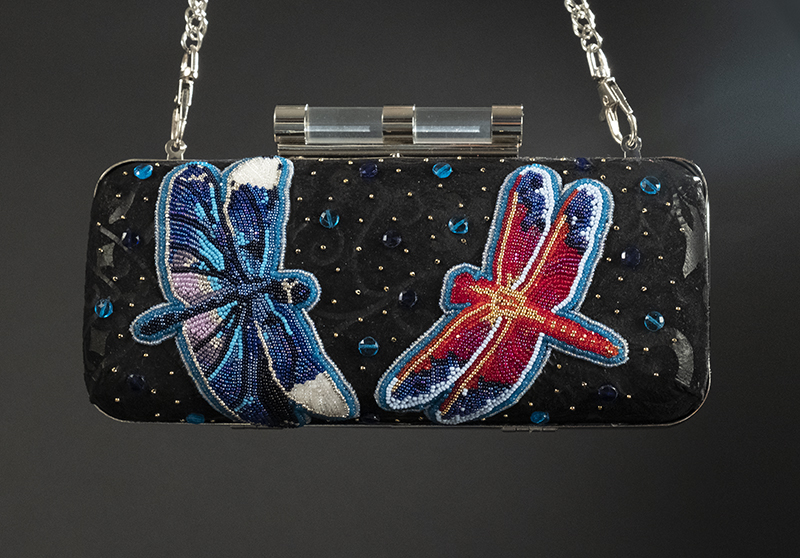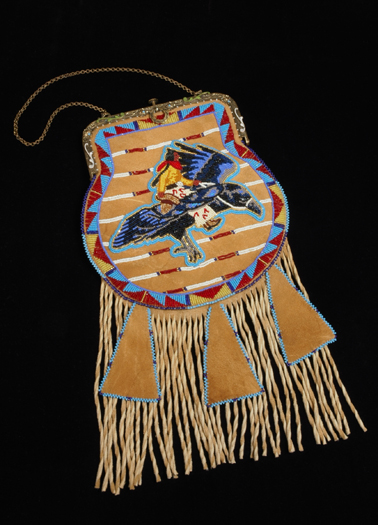-
 Transporters of Dreams13/0 Cut Beads, 24k Gold Beads, Sterling Silver Beads, Antique Czech Nailhead Spots, Italian Leather, Acrylic, ChainSOLD
Transporters of Dreams13/0 Cut Beads, 24k Gold Beads, Sterling Silver Beads, Antique Czech Nailhead Spots, Italian Leather, Acrylic, ChainSOLD -
 My Little Urban Pony – SkateboardLongboard, Cut Glass Beads, 24k Gold Beads, Antique Navajo Silver Buttons, Traditional Earth Pigments, Painted and Tanned Deer Hide
My Little Urban Pony – SkateboardLongboard, Cut Glass Beads, 24k Gold Beads, Antique Navajo Silver Buttons, Traditional Earth Pigments, Painted and Tanned Deer Hide- 9.25"h
- 44"w
- 4"d
SOLD -
 Tell Me the Story of How the Sun Loved the Moon So Much, He Died Every Night to Let Her BreatheVintage Double-Cut Charlotte Beads, 24kt Gold Cut Beads, Sterling Silver Cut Beads, Dentalium Shells, Abalone Beads, Vintage "Blue Russian" Style Beads, Brain-Tanned Hide, Wool, Fabric, Red Ochre Paint
Tell Me the Story of How the Sun Loved the Moon So Much, He Died Every Night to Let Her BreatheVintage Double-Cut Charlotte Beads, 24kt Gold Cut Beads, Sterling Silver Cut Beads, Dentalium Shells, Abalone Beads, Vintage "Blue Russian" Style Beads, Brain-Tanned Hide, Wool, Fabric, Red Ochre Paint- 15"h
- 10"w
- 1"d
SOLD -
 I am the Day. I am the Night.Smoked Brain Tanned Elk Hide, Glass Seed Beads, 14K Gold and Sterling Silver Seed Beads, Bells, FeathersSOLD
I am the Day. I am the Night.Smoked Brain Tanned Elk Hide, Glass Seed Beads, 14K Gold and Sterling Silver Seed Beads, Bells, FeathersSOLD -
 Jackson Sundown Rides RavenHide, Antique Micro Beads, 24K Gold Plated BeadsSOLD
Jackson Sundown Rides RavenHide, Antique Micro Beads, 24K Gold Plated BeadsSOLD -
 Banner Forest Bear DrumRaw Hide, Acrylic, Brass Tacks, Glass Claw, Bells, Glass Beads, Inside Satchel: Sage, Tobacco, Bear Root
Banner Forest Bear DrumRaw Hide, Acrylic, Brass Tacks, Glass Claw, Bells, Glass Beads, Inside Satchel: Sage, Tobacco, Bear Root- 18.25"h
- 20.75"w
- 3"d
SOLD
Angela Swedberg has been a professional conservator and restoration specialist of 19th Century Native American Art (With a emphasis on Plateau beadwork) for over 30 years. She is also an accomplished artist, using her extensive knowledge of beadwork, quillwork, and leatherworking to make historic style, but original artworks, as well as contemporary modern work, which often includes blown and cast art glass as a narrative. Swedberg is a tribally certified Indian Artisan, in full accordance of the Indian Arts and Crafts Act of 1990.
Swedberg has her original works in numerous museum permanent collections, as well as having done restoration on museum art collections. Her artwork is included in the permanent collections of The Denver Art Museum, Portland Art Museum, Maryhill Museum of Art, The Glenbow, The Russel Museum among others. She also restores art for the private sector.
Swedberg has been Artist in Residence at the prestigious Pilchuck Glass School, and won the Hauberg glass art fellowship. She also was a participant in the National Folk Festival, demonstrating 19th Century Plateau Horse gear with her Appaloosa “Cappy”, and served as the lead rider in the opening ceremony. She is featured in numerous books, including “A Beading Heart” which she wrote about the Sandroni collection. She also curated the art exhibit at the Clark County Historical Museum “Making Beauty” which was on display from November 2015 to November 2017.
Her most recent accomplishments have been making an 8 piece set of Plateau horse gear for permanent display at the Denver Art Museum, narrating environmental issues that affect the Peoples of the Plateau. She has been awarded a research fellowship studying historic Plateau clothing and cultural items, at the Bill Holm Center, Burke Museum, University of Washington. Swedberg also just was awarded the “Peace and Friendship” medal by the Washington State Historical Society for fostering cultural understanding of Native people and arts to non-natives. Swedberg lives and works in Port Orchard, Washington, where she divides her time between her restoration and conservation work, artwork, historical research, and riding and training horses.
